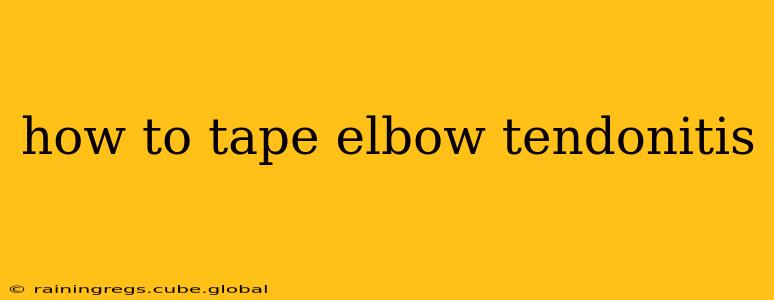Elbow tendonitis, encompassing conditions like golfer's elbow and tennis elbow, can be incredibly painful and debilitating. While medical attention is crucial for diagnosis and treatment, taping techniques can offer significant pain relief and support, aiding in recovery and preventing further injury. This guide explores effective taping methods for elbow tendonitis, addressing common questions and concerns.
What are the benefits of taping for elbow tendonitis?
Taping for elbow tendonitis offers several key benefits:
- Pain Reduction: Strategic placement of tape can alleviate pain by reducing inflammation and providing compression to the affected area. This compression can also help to stabilize the joint and reduce strain on the tendons.
- Improved Proprioception: Taping can enhance your body's awareness of your elbow's position and movement, leading to better control and reduced risk of re-injury.
- Increased Support: The tape provides external support to the weakened tendons, taking some of the strain off during activities.
- Reduced Inflammation: Depending on the type of tape used, it can help manage swelling and inflammation.
- Enhanced Blood Circulation: In some cases, specific taping techniques can improve blood flow to the affected area, promoting healing.
What type of tape is best for elbow tendonitis?
Several types of tape can be effective for elbow tendonitis. The most common choices are:
- Kinesiology Tape: This elastic, breathable tape is designed to lift the skin and improve blood flow while providing support. It's known for its comfort and ability to allow for a full range of motion.
- Athletic Tape: This stiffer, non-elastic tape offers more rigid support and is often used for more severe cases or to provide extra stability during activity. However, it may restrict movement more than kinesiology tape.
- Pre-cut strips (various materials): Many brands now offer pre-cut strips designed specifically for elbow support. These can be a convenient option, particularly for beginners.
How do I tape my elbow for tendonitis? (Step-by-step for Kinesiology Tape)
This technique focuses on Kinesiology tape due to its versatility and comfort. Remember, proper application is crucial for effectiveness and to avoid skin irritation. Always consult a physical therapist or medical professional for personalized guidance.
Materials: Kinesiology tape, scissors, and alcohol wipes (for cleaning the skin).
Steps:
- Clean the skin: Use alcohol wipes to clean the area of skin where you'll apply the tape. This helps the tape adhere better.
- Assess the affected area: Identify the specific location of your pain and tenderness. This will help determine the best placement of the tape.
- Anchor Point: Start by anchoring the end of the tape about 2 inches below the elbow crease, on the inner side of the arm, with the skin slightly stretched.
- Application: Apply the tape with a gentle stretch (around 25-50%) following the direction of the muscle fibers. For medial epicondylitis (Golfer's elbow), apply the tape from the inner elbow upward towards the forearm. For lateral epicondylitis (Tennis elbow), apply from the outer elbow toward the forearm.
- Overlapping Strips: Apply multiple overlapping strips, continuing to follow the muscle fibers' direction. The overlapping strips will reinforce support.
- Smooth the edges: Once all strips are applied, firmly rub the tape to ensure proper adhesion and improve its lasting power.
- Monitor and Adjust: Check your tape regularly for discomfort or slipping. You might need adjustments depending on your activity levels.
(Note: Athletic tape application is similar but without the stretch, providing more rigid support.)
How long should I wear the tape?
The duration you wear the tape depends on several factors, including the type of tape used, your activity level, and your comfort level. Generally, kinesiology tape can be worn for several days, even up to a week, while athletic tape is often removed daily or every few days.
Does taping help with golfer's elbow and tennis elbow specifically?
Yes, taping can be highly beneficial for both golfer's elbow (medial epicondylitis) and tennis elbow (lateral epicondylitis). The taping techniques will vary slightly depending on the specific condition, focusing on the affected muscles and tendons. See a physical therapist for personalized instructions based on your diagnosis.
Can I use taping along with other treatments?
Absolutely! Taping is a complementary therapy and can be used alongside other treatments such as physical therapy, medication, and rest. It shouldn't be seen as a replacement for medical advice but rather as a supportive measure to aid your recovery.
When should I see a doctor about my elbow tendonitis?
If your elbow pain is severe, persistent, or doesn't improve with conservative treatments like rest and taping, it's crucial to seek medical attention. A doctor can diagnose the underlying cause of your pain and recommend appropriate treatment options. Don't hesitate to seek professional help if you experience numbness, tingling, or significant weakness in your arm.
This information is for educational purposes only and should not be considered medical advice. Always consult with a healthcare professional before starting any new treatment for elbow tendonitis. They can assess your condition, provide a proper diagnosis, and recommend the most appropriate treatment plan for your individual needs.
